 Your ears will be in a constant state of bemused percolation, your eyeballs will feel like they have been soaking in a tepid pool of lumpy sick for five days straight, and your overly inflamed genitals will be crying out for more softening jelly, welcome to the orifice-challenging world of Life on the Edge, a gigantic slab of cinematic weird about a family, who, funny enough, live in the vicinity of an edge. Why, may I ask, will my many holes under so much duress while watching this highly imaginative endeavour wiggle its way across my viewing screen? Well, it should go without saying, but in my mind, film’s that fail to provoke your respective apertures aren’t worth the time or the energy it takes to properly absorb them. Let me put it like this: While I’m watching a movie, and, make no mistake, this is a movie, I want every crack, vent, slit and fissure to be filled with wad after wad of creamy hardship. Unfortunately, my existence has been a tad lacking as of late when it comes to sturdy tubes forcibly trying to cram themselves into any one of my many gaping holes. Now, before your brain becomes awash with sadness over my apparent tube and hole deficiency, think about how limited your tube and hole situation is. Pretty grim, isn’t it? On the bright side, I do have a hole that causes unwanted fecal matter to magically disappear with the flick of a slightly effeminate wrist. And that’s not all, I also have access to this tube-like entity that allows me to look at pictures of Shelley Duvall whenever I want. Of course, what I do with my excrement while looking at photos of the lithesome actress is none of your business. My point is, what if we lived in a universe where our every need was taken care of by a series of holes connected to tubes?
Your ears will be in a constant state of bemused percolation, your eyeballs will feel like they have been soaking in a tepid pool of lumpy sick for five days straight, and your overly inflamed genitals will be crying out for more softening jelly, welcome to the orifice-challenging world of Life on the Edge, a gigantic slab of cinematic weird about a family, who, funny enough, live in the vicinity of an edge. Why, may I ask, will my many holes under so much duress while watching this highly imaginative endeavour wiggle its way across my viewing screen? Well, it should go without saying, but in my mind, film’s that fail to provoke your respective apertures aren’t worth the time or the energy it takes to properly absorb them. Let me put it like this: While I’m watching a movie, and, make no mistake, this is a movie, I want every crack, vent, slit and fissure to be filled with wad after wad of creamy hardship. Unfortunately, my existence has been a tad lacking as of late when it comes to sturdy tubes forcibly trying to cram themselves into any one of my many gaping holes. Now, before your brain becomes awash with sadness over my apparent tube and hole deficiency, think about how limited your tube and hole situation is. Pretty grim, isn’t it? On the bright side, I do have a hole that causes unwanted fecal matter to magically disappear with the flick of a slightly effeminate wrist. And that’s not all, I also have access to this tube-like entity that allows me to look at pictures of Shelley Duvall whenever I want. Of course, what I do with my excrement while looking at photos of the lithesome actress is none of your business. My point is, what if we lived in a universe where our every need was taken care of by a series of holes connected to tubes?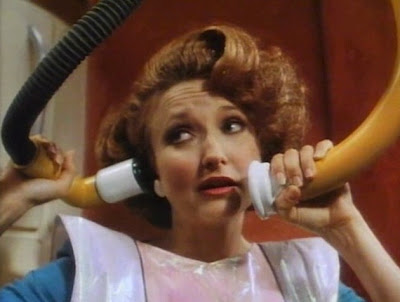 Well, in the stain-covered realm where Life on the Edge (a.k.a. Rohr frei für Familie Hollowhead) takes place (a domain where getting smeared with some sort of tubal discharge is an hourly occurrence), your every whim is provided for you thanks to the incorruptible tube and hole enthusiasts over at United Umbilical, a benevolent corporation dedicated to providing everything an upwardly mobile family could possibly desire in these precipice preoccupied times. Opening with a shot of the structural makeup of an unnamed subterranean macrocosm, the camera enters a large, grimy a tube, and we’re quickly sucked into the state-of-the-art kitchen of Miriam Hollowhead (Nancy Mette), a dedicated mother, a subtle leg tease, and a master when it comes to handling flexible cylinders under pressure.
Well, in the stain-covered realm where Life on the Edge (a.k.a. Rohr frei für Familie Hollowhead) takes place (a domain where getting smeared with some sort of tubal discharge is an hourly occurrence), your every whim is provided for you thanks to the incorruptible tube and hole enthusiasts over at United Umbilical, a benevolent corporation dedicated to providing everything an upwardly mobile family could possibly desire in these precipice preoccupied times. Opening with a shot of the structural makeup of an unnamed subterranean macrocosm, the camera enters a large, grimy a tube, and we’re quickly sucked into the state-of-the-art kitchen of Miriam Hollowhead (Nancy Mette), a dedicated mother, a subtle leg tease, and a master when it comes to handling flexible cylinders under pressure.
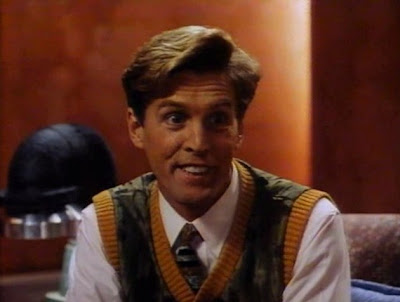 Working hard to prepare a consumable meal for her husband, Henry Hollowhead (John Glover), a meter reader voted best meter reader in his district three cycles in a row, and his boss, Marty Crabneck (Richard Portnow), the pantyhose-inhaling CEO of United Umbilical, Miriam is shocked to discover that some of her tubes have become blocked, seriously jeopardizing her dinner plans. She hopes to rectify this problem being sending her son, Billy Hollowhead (Matt Shakman), along with his mischievous pal Joey (Joshua John Miller), out to get more ingredients (the latter is currently spraying the walls of Billy’s room with coagulated insect blood) at the nearest pumping station. However, this means the two youngsters have to venture out near the edge, a pitch black netherworld that may or may not contain an edge (a missing classmate of theirs is rumoured to have fallen off the edge).
Working hard to prepare a consumable meal for her husband, Henry Hollowhead (John Glover), a meter reader voted best meter reader in his district three cycles in a row, and his boss, Marty Crabneck (Richard Portnow), the pantyhose-inhaling CEO of United Umbilical, Miriam is shocked to discover that some of her tubes have become blocked, seriously jeopardizing her dinner plans. She hopes to rectify this problem being sending her son, Billy Hollowhead (Matt Shakman), along with his mischievous pal Joey (Joshua John Miller), out to get more ingredients (the latter is currently spraying the walls of Billy’s room with coagulated insect blood) at the nearest pumping station. However, this means the two youngsters have to venture out near the edge, a pitch black netherworld that may or may not contain an edge (a missing classmate of theirs is rumoured to have fallen off the edge).
 Penetrating the darkness with a playful yet reluctant glee, they finally arrive at the pumping station only to find a Reamer (Lee Arenberg) yelling orders at a bunch of Reamers (they’re in charge of keeping the tubes clean, and do so via the brush-like bristles they wear around their waists). After having some fun at the Reamer’s expense, Billy and Joey run into Babbleaxe (Anne Ramsey), a bigwig at tube central, who furnishes them with enough brackish water to fill up eight to ten festering pustules.
Penetrating the darkness with a playful yet reluctant glee, they finally arrive at the pumping station only to find a Reamer (Lee Arenberg) yelling orders at a bunch of Reamers (they’re in charge of keeping the tubes clean, and do so via the brush-like bristles they wear around their waists). After having some fun at the Reamer’s expense, Billy and Joey run into Babbleaxe (Anne Ramsey), a bigwig at tube central, who furnishes them with enough brackish water to fill up eight to ten festering pustules.
 Meanwhile, back at casa de Hollowhead, Cindy Hollowhead (Juliette Lewis), Miriam and Henry Hollowhead’s succulent teenage daughter (rumour has it, her pussy tastes like candy), is trying to focus on an upcoming social function of some importance. After applying her make-up using her wall-mounted make-up mask (it shoots lipstick, eyeliner, rouge, mascara, and blush onto her face through a series of tubes), it’s obvious that Cindy is finding the strain of adolescence too much to bear. She attempts to work through some of these issues by employing a totally awesome dress up montage. But, unfortunately, Billy catches her while she’s in the middle of practicing her sexy voice in her bedroom mirror. Using the feeding of their basement-dwelling grandfather as a bargaining chip, Billy promises not to tell anyone about her mirror antics if she agrees to administer his meals for the next three terms.
Meanwhile, back at casa de Hollowhead, Cindy Hollowhead (Juliette Lewis), Miriam and Henry Hollowhead’s succulent teenage daughter (rumour has it, her pussy tastes like candy), is trying to focus on an upcoming social function of some importance. After applying her make-up using her wall-mounted make-up mask (it shoots lipstick, eyeliner, rouge, mascara, and blush onto her face through a series of tubes), it’s obvious that Cindy is finding the strain of adolescence too much to bear. She attempts to work through some of these issues by employing a totally awesome dress up montage. But, unfortunately, Billy catches her while she’s in the middle of practicing her sexy voice in her bedroom mirror. Using the feeding of their basement-dwelling grandfather as a bargaining chip, Billy promises not to tell anyone about her mirror antics if she agrees to administer his meals for the next three terms.
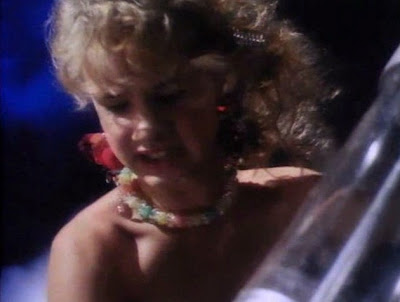 Administer his meals?!? Why, that’s an odd way of putting it. This, however, should come as no surprise, as every action in Life on the Edge is performed in a somewhat off-kilter manner. And the feeding of the elderly is no different. After navigating an ominous-looking hallway (ninety-nine percent of the corridors in the Hollowhead household contain properties that are ominous in nature), Cindy comes to a door that leads to some kind of boiler room. Once inside, she walks towards a dishevelled man strapped to a dentist chair. When she’s done making sure that his bib is on securely, Cindy lifts up a giant syringe and proceeds to inject the senile old coot with enough sustenance to last him until the next term. As she began to attach the syringe to his feeding tube, my eyes began to widen when I noticed that the liquified sludge masquerading as food inside Cindy’s syringe was in fact iridescent. Hallelujah! We have iridescent sludge in a syringe! We have iridescent sludge in a syringe! Truth be told, it’s the only reason I watch movies anymore, and there it was, shimmering in its translucent housing like a deformed baby taking a well-deserved nap on a bed of radioactive hair curlers.
Administer his meals?!? Why, that’s an odd way of putting it. This, however, should come as no surprise, as every action in Life on the Edge is performed in a somewhat off-kilter manner. And the feeding of the elderly is no different. After navigating an ominous-looking hallway (ninety-nine percent of the corridors in the Hollowhead household contain properties that are ominous in nature), Cindy comes to a door that leads to some kind of boiler room. Once inside, she walks towards a dishevelled man strapped to a dentist chair. When she’s done making sure that his bib is on securely, Cindy lifts up a giant syringe and proceeds to inject the senile old coot with enough sustenance to last him until the next term. As she began to attach the syringe to his feeding tube, my eyes began to widen when I noticed that the liquified sludge masquerading as food inside Cindy’s syringe was in fact iridescent. Hallelujah! We have iridescent sludge in a syringe! We have iridescent sludge in a syringe! Truth be told, it’s the only reason I watch movies anymore, and there it was, shimmering in its translucent housing like a deformed baby taking a well-deserved nap on a bed of radioactive hair curlers.
 Even though I feel like a pathetic pipe seed for asking, but is it okay if I use this space to describe the outfits Cindy tries on during her totally awesome dress up montage? It is? Well, gosh golly, you scuzzy pumpsucker, my tubes are flusher than a recently molested apricot. Anxious to look her best for the party, Cindy tries on five outfits to the apt strains of “I Feel Good About Myself,” a catchy ditty written by Glenn A. Jordan and sung by Mendy Lee.
Even though I feel like a pathetic pipe seed for asking, but is it okay if I use this space to describe the outfits Cindy tries on during her totally awesome dress up montage? It is? Well, gosh golly, you scuzzy pumpsucker, my tubes are flusher than a recently molested apricot. Anxious to look her best for the party, Cindy tries on five outfits to the apt strains of “I Feel Good About Myself,” a catchy ditty written by Glenn A. Jordan and sung by Mendy Lee.
 Outfit #1: Starting things off with a super-tight pink and black checkerboard dress with striped sleeves, Cindy, her legs encased in black pantyhose, practices arching her back and thrusting the uncertainty-laden contents of her still developing vaginal expanse in front of the full-length located in her bedroom. Outfit #2: The next article of clothing to rub up against her maidenly skin is a silver ballerina-style dress covered with sequins. While modeling this particular garment, Cindy pretends that the playful extensions she’s added to her hair are, in actuality, part of her face (a girl’s desire to have a mustache is perfectly normal, as it shows that they’re itching to mature).
Outfit #1: Starting things off with a super-tight pink and black checkerboard dress with striped sleeves, Cindy, her legs encased in black pantyhose, practices arching her back and thrusting the uncertainty-laden contents of her still developing vaginal expanse in front of the full-length located in her bedroom. Outfit #2: The next article of clothing to rub up against her maidenly skin is a silver ballerina-style dress covered with sequins. While modeling this particular garment, Cindy pretends that the playful extensions she’s added to her hair are, in actuality, part of her face (a girl’s desire to have a mustache is perfectly normal, as it shows that they’re itching to mature).
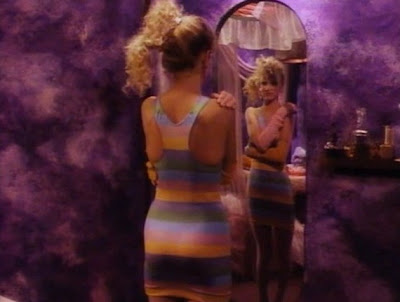 Outfit #3: Yet another super-tight ensemble, Cindy’s subsequent get-up is a curve-hugging, rainbow-inspired frock that has been matched with opera gloves, one orange and one pink, and a pair of mauve tights (the sound of the mauve fabric grinding together as she crossed her legs must have been, in a word, exquisite). This impish outfit was my personal favourite, as it employs unorthodox colours without sacrificing any of its innate chic appeal.
Outfit #3: Yet another super-tight ensemble, Cindy’s subsequent get-up is a curve-hugging, rainbow-inspired frock that has been matched with opera gloves, one orange and one pink, and a pair of mauve tights (the sound of the mauve fabric grinding together as she crossed her legs must have been, in a word, exquisite). This impish outfit was my personal favourite, as it employs unorthodox colours without sacrificing any of its innate chic appeal.
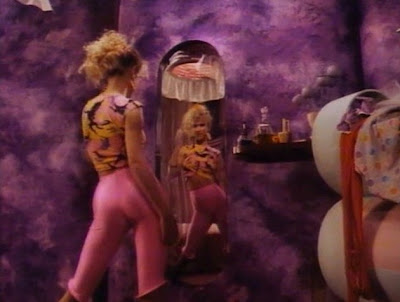 Outfit #4: The tight motif continues unabated as Cindy deploys a tight-fitting pair of pink capri pants. Choosing to wear a belly-revealing top that had a distinctly tropical theme, you’d think the monochromatic make-up of the trousers would clash with the top’s more polychromatic personality. But, in fact, the exact opposite occurs, as the two pieces seemed to coalesce with one another in a way that was quite unexpected.
Outfit #4: The tight motif continues unabated as Cindy deploys a tight-fitting pair of pink capri pants. Choosing to wear a belly-revealing top that had a distinctly tropical theme, you’d think the monochromatic make-up of the trousers would clash with the top’s more polychromatic personality. But, in fact, the exact opposite occurs, as the two pieces seemed to coalesce with one another in a way that was quite unexpected.
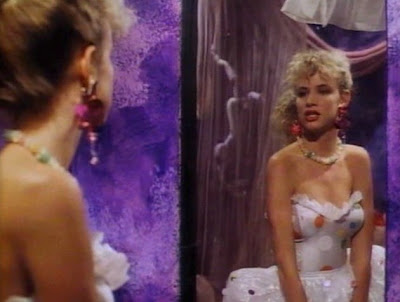 Outfit #5: Proving that her closet is a bottomless pit in terms of haute couture diversity, Cindy’s fifth, and, sadly, final outfit to be featured in the totally awesome dress up montage, is a puffy polka-dot dress that she has decided to wear with a pair of white frilly gloves. Content in the knowledge that her abundantly juicy gams are, to quote the not great Robin Leach from Troop Beverly Hills, “smashingly sheathed” in the tightest pair of white pantyhose this side of Contra Costa County, Cindy stares at herself in the mirror, and, after a second or two, makes an age inappropriate kissy face, and mouths the words “yes” to herself, signifying that she has made her choice.
Outfit #5: Proving that her closet is a bottomless pit in terms of haute couture diversity, Cindy’s fifth, and, sadly, final outfit to be featured in the totally awesome dress up montage, is a puffy polka-dot dress that she has decided to wear with a pair of white frilly gloves. Content in the knowledge that her abundantly juicy gams are, to quote the not great Robin Leach from Troop Beverly Hills, “smashingly sheathed” in the tightest pair of white pantyhose this side of Contra Costa County, Cindy stares at herself in the mirror, and, after a second or two, makes an age inappropriate kissy face, and mouths the words “yes” to herself, signifying that she has made her choice.
 As a triumphant Cindy is basking in the self-satisfied glow that usually follows a well-orchestrated dress up montage, Miriam Hollowhead still slaving away in the kitchen. Whether sucking the black out of a black eye, making one of her “specials” (which looked like some kind of amphibian burrito), or luring the penis-like creature that lives in the kitchen wall out of its hole so that she may chop it up into a dozen or so pieces, Miriam is a domestic goddess. Rarely seen without her pink apron and pink rubber gloves, Miriam, the waves in her hair sculptured to perfection, is an expert when it comes to extracting gooey fluid from rigid tubes, an important skill to have in a world replete with hollow passageways and bulky ruptures.
As a triumphant Cindy is basking in the self-satisfied glow that usually follows a well-orchestrated dress up montage, Miriam Hollowhead still slaving away in the kitchen. Whether sucking the black out of a black eye, making one of her “specials” (which looked like some kind of amphibian burrito), or luring the penis-like creature that lives in the kitchen wall out of its hole so that she may chop it up into a dozen or so pieces, Miriam is a domestic goddess. Rarely seen without her pink apron and pink rubber gloves, Miriam, the waves in her hair sculptured to perfection, is an expert when it comes to extracting gooey fluid from rigid tubes, an important skill to have in a world replete with hollow passageways and bulky ruptures.
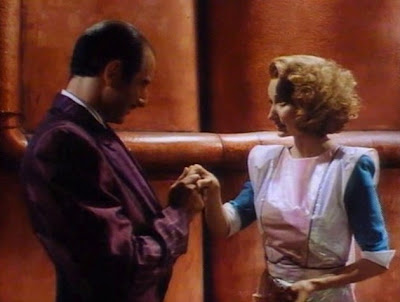 When their guest finally does arrive, Henry Hollowhead finds himself up a purge pipe without a paddle, as Miriam’s shapely stems, not his promotion, seem to be the focal point of Mr. Crabneck’s uncouth gaze. Seriously, her nectareous wheels are under constant ocular bombardment from the wonderfully depraved CEO, a timing-obsessed lech in a purple pinstriped suit. While I didn’t exactly agree with his views on child rearing, or his dislike for rationalism (his ex-wife was a rationalist, but, then again, he only married her because she was a “sumptuous piece of throbbing flesh”), but I did find myself nodding in agreement whenever he interacted with Miriam and Cindy Hollowhead. Using words like, “enticing,” “alluring,” and “suggestive” to describe them, Mr. Crabneck (who, just for record, likes it when women call him “Marty”) is probably one of the most aggressively horny characters to land on my plate in quite some time.
When their guest finally does arrive, Henry Hollowhead finds himself up a purge pipe without a paddle, as Miriam’s shapely stems, not his promotion, seem to be the focal point of Mr. Crabneck’s uncouth gaze. Seriously, her nectareous wheels are under constant ocular bombardment from the wonderfully depraved CEO, a timing-obsessed lech in a purple pinstriped suit. While I didn’t exactly agree with his views on child rearing, or his dislike for rationalism (his ex-wife was a rationalist, but, then again, he only married her because she was a “sumptuous piece of throbbing flesh”), but I did find myself nodding in agreement whenever he interacted with Miriam and Cindy Hollowhead. Using words like, “enticing,” “alluring,” and “suggestive” to describe them, Mr. Crabneck (who, just for record, likes it when women call him “Marty”) is probably one of the most aggressively horny characters to land on my plate in quite some time.
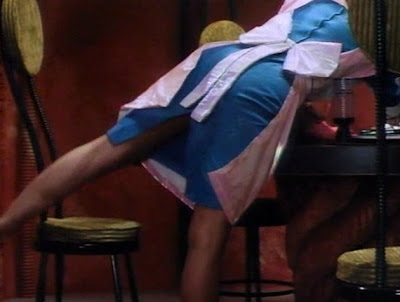 I’ll admit, there are a number of questions regarding certain aspects of Life on the Edge rattling around inside my brain at the moment. For instance, what’s a “punitration box;” how does one go about “de-penetrating” a parasite-infested dog; what do they feed that eyeball squid thingy in the Hollowhead’s front room; is the chicken-trombone, sixteen shells from a thirty-ought six-esque synthesizer that Bud Hollowhead (Lightfield Lewis) is seen playing at one point a difficult instrument to master; and what exactly lies beyond the edge? However, my biggest question, the one that’s been burning a giant hole in my subconscious for the last eleven cycles, has got to be: What the edge is softening jelly?
I’ll admit, there are a number of questions regarding certain aspects of Life on the Edge rattling around inside my brain at the moment. For instance, what’s a “punitration box;” how does one go about “de-penetrating” a parasite-infested dog; what do they feed that eyeball squid thingy in the Hollowhead’s front room; is the chicken-trombone, sixteen shells from a thirty-ought six-esque synthesizer that Bud Hollowhead (Lightfield Lewis) is seen playing at one point a difficult instrument to master; and what exactly lies beyond the edge? However, my biggest question, the one that’s been burning a giant hole in my subconscious for the last eleven cycles, has got to be: What the edge is softening jelly?
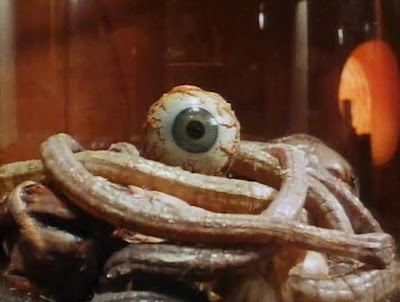 The enigmatic substance is brought up several times over the course of the film, but nowhere near as much as it is during Miriam and Cindy’s impromptu mother-daughter chat. While the exact nature its usage remains a mystery, I still couldn’t help but notice that every time the words “softening jelly” are uttered, my mind would envision all these different ways the perplexing product could be used. Of course, the majority of these uses involved slowly spreading it over Cindy’s quivering clitoris. Either way, the mystifying aura that surrounded softening jelly is an excellent example as to why this movie was so appealing to me. It never goes out of its way to explain its weirdness, because, to them, it wasn’t weird, living life on the edge was as normal as mixing vapours.
The enigmatic substance is brought up several times over the course of the film, but nowhere near as much as it is during Miriam and Cindy’s impromptu mother-daughter chat. While the exact nature its usage remains a mystery, I still couldn’t help but notice that every time the words “softening jelly” are uttered, my mind would envision all these different ways the perplexing product could be used. Of course, the majority of these uses involved slowly spreading it over Cindy’s quivering clitoris. Either way, the mystifying aura that surrounded softening jelly is an excellent example as to why this movie was so appealing to me. It never goes out of its way to explain its weirdness, because, to them, it wasn’t weird, living life on the edge was as normal as mixing vapours.
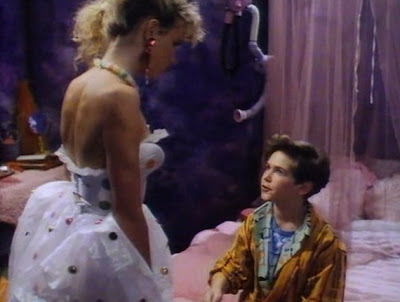 The only aspects I had trouble with were the rap song that played over the opening credits, Billy’s unnecessary narration, and Bobcat Goldthwaite’s line, “just say no to butt polish.” The only reason I didn’t care for the butt polish line (“butt polish,” by the way, is the edgiverse equivalent of sniffing glue) was because it reminded me of Nancy Reagan’s “just say no” catchphrase, and that’s last thing I want to be reminded of when I’m watching a movie where Juliette Lewis has a two-pronged side ponytail. That being said, the script by Lisa Morton and Thomas Burman full of rich and clever dialogue, the film’s production design by Edward Eyth and the art direction by Michael Stuart was mind-blowing (the amount work that went into the design of the Hollowhead kitchen alone must have been exhaustive), and, of course, the costumes by Eduardo Castro were, well, you know, superb. A demented sitcom for those who despise laugh tracks, and the lazy writing that usually accompanies them, Life on the Edge is an inspired glob of tactile genius. Good shift.
The only aspects I had trouble with were the rap song that played over the opening credits, Billy’s unnecessary narration, and Bobcat Goldthwaite’s line, “just say no to butt polish.” The only reason I didn’t care for the butt polish line (“butt polish,” by the way, is the edgiverse equivalent of sniffing glue) was because it reminded me of Nancy Reagan’s “just say no” catchphrase, and that’s last thing I want to be reminded of when I’m watching a movie where Juliette Lewis has a two-pronged side ponytail. That being said, the script by Lisa Morton and Thomas Burman full of rich and clever dialogue, the film’s production design by Edward Eyth and the art direction by Michael Stuart was mind-blowing (the amount work that went into the design of the Hollowhead kitchen alone must have been exhaustive), and, of course, the costumes by Eduardo Castro were, well, you know, superb. A demented sitcom for those who despise laugh tracks, and the lazy writing that usually accompanies them, Life on the Edge is an inspired glob of tactile genius. Good shift.
video uploaded by BrainNepherit

